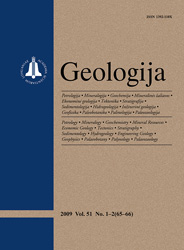Geologija / Geology
 ISSN 1392-110X ISSN 2029-056X (online) |
2008 m. Nr. 2 The nature of the so-called ‘reefs’ in the Pridolian carbonate system of the Silurian Baltic basin
Bičkauskas G., Molenaar N. The nature of the so-called ‘reefs’ in the Pridolian carbonate system of the Silurian Baltic basin. Geologija. Vilnius. 2008. Vol. 50. No. 2(62). P. 94–104. ISSN 1392-110X
There is a growing interest in different aspects of carbonate reservoirs because of the importance of a number of large and giant carbonate oilfields in the Middle East and the Caspian Sea area. A number of these reservoirs are found in Palaeozoic carbonates. Silurian carbonates in the Silurian Baltic Basin form an excellent target for research because of the availability of numerous cores and outcrops and a limited impact of tectonic deformation in this marginal cratonic basin. This research is focused on Pridolian carbonates, including shallow to deep basin facies, in the Lithuanian subsurface. In this paper, a new opinion will be presented about the sedimentological nature of the so-called reefs in this basin. The term reef appears often loosely applied to different types of deposits. Although the tectonic synsedimentary setting is undoubtedly important, it is however crucial to determine the exact nature of the reefal deposits because they tend to determine the nature of the carbonate system. In case of real reefs, i. e. bioconstructed deposits with a significant relief, carbonate platforms while otherwise ramps develop. The research shows that Pridolian carbonates lack reefs since the framework-constructing fauna is absent, and probably was absent during most of the Palaeozoic. Contrary to bioherms or reefs, biostromal deposits are formed on a ramp system and appear to be one of the main carbonate-producing parts of the system. The exact importance of the different facies belts in carbonate production is difficult to assess. It is crucial to distinguish between the ramp and the platform systems because these two end member systems react differently to diagenesis which ultimately determines the petrophysical properties and thus the reservoir quality. Keywords: carbonates, reef, biostrome, ramp, Silurian Baltic Basin, Pridoli |
Issues:
2011 - Vol.53 No. 1, No. 2, No. 3 2010 - Vol.52 No. 1-4 2009 - Vol.51 No. 1-2, No. 3-4 2008 - Vol.50 No. 1, No. 2, No. 3, No. 4, No. Priedas 2007 No. 1, No. 2, No. 3, No. 4 2006 No. 1, No. 2, No. 3, No. 4 2005 No. 1, No. 2, No. 3, No. 4 2004 No. 1, No. 2, No. 3, No. 4 2003 No. 1, No. 2, No. 3, No. 4 2002 No. 1, No. 2, No. 3, No. 4 2001 No. 1, No. 2, No. 3, No. 4 |